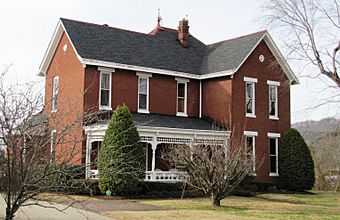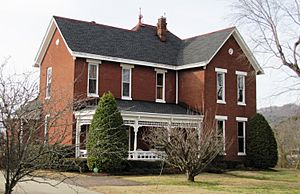Davis-Hull House facts for kids
Quick facts for kids |
|
|
Davis-Hull Mansion
|
|

The Davis-Hull Mansion in 2010
|
|
| Location | 1004 North Main Street, Carthage, Tennessee |
|---|---|
| Area | 1.6 acres (0.65 ha) |
| Built | 1889 |
| Architect | Calvin Davis |
| Architectural style | Late Victorian |
| NRHP reference No. | 83003069 |
| Added to NRHP | January 4, 1983 |
The Davis-Hull House is a historic home located at 1004 North Main Street in Carthage, Tennessee. This special house was officially added to the National Register of Historic Places on January 4, 1983. Being on this list means it's an important place worth protecting because of its history.
Contents
The Davis-Hull House: A Look Inside Its History
This house has a long and interesting past. It was built over 130 years ago! Let's explore who lived here and what makes it special.
Who Built This Historic Home?
The land where the Davis-Hull House stands first belonged to E. L. Gardenshire. In 1889, a man named Calvin N. Davis bought the land. Calvin Davis had served in the Confederate States Army during the Civil War. After the war, he worked as a merchant in Nashville, Tennessee.
In 1889, Davis moved to Carthage with his wife and eight children. He was a busy person in Carthage. He helped start two important local businesses: the Rewoda Milling Company and the Carthage Tobacco Works.
Building a Victorian Masterpiece
Soon after buying the land in 1889, Calvin Davis built this two-story house. He designed it in the popular Victorian architectural style of that time. Victorian homes often have fancy details, tall windows, and interesting shapes.
A Home with Many Stories
Over the years, many different families lived in the Davis-Hull House. Each family added to its story.
Early Owners and School Connections
In 1900, T. P. Bridges bought the house. Four years later, in 1904, J. H. Officer became the owner. Officer rented out rooms to Professor W. T. Call and his students. These students attended the Joseph W. Allen School, which was right next door. The school building is no longer there today.
The Hull Family's Time
In 1906, William Hull purchased the house. He was the father of a very famous person: Cordell Hull. Cordell Hull later became the United States Secretary of State from 1933 to 1944. The Secretary of State is a top government official who handles how America talks to other countries. Cordell Hull himself only lived in this house for a short time in 1907.
Later Families and Preservation
By 1914, the house was sold to Arthur H. Hackett. His daughter, Gladys Hackett Moore, bought it in 1920. Her son then acquired the house in 1976. The house continues to be a private home today, preserving its history for future generations.




